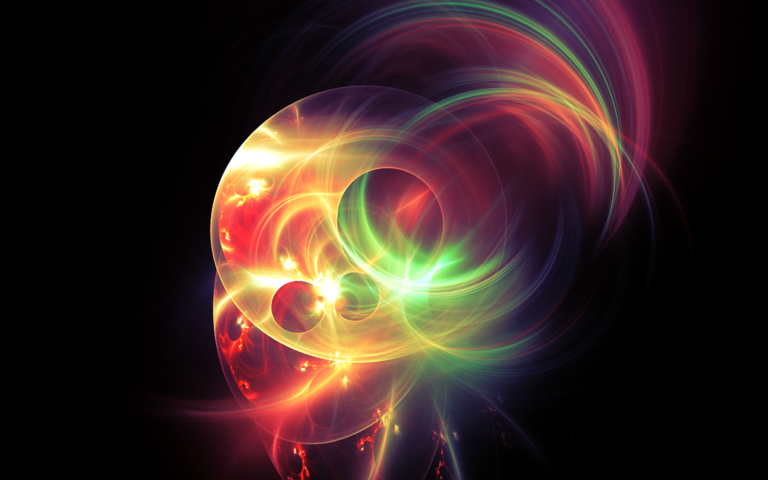
by Dr. Paola Sensini and Prof. Antonio Mercurio
This paper was written by me and Antonio, by working in the following manner: first we explored together what we each knew about the masculine principle and the feminine principle; then we wrote down only those things that we both agreed on; finally, we watched a film about fecundation and from this we gathered possible behavioral “analogies” that we could offer to both partners within a couple. I, then, used my knowledge of the book the “I Ching” and found some essential ideas regarding this theme, and again working as a couple we gave a final form to the text.
We want to present to you some considerations on the masculine principle and the feminine principle that can be useful for the couple experience, within a historical and social context. We feel it is first important to make the concept of the masculine principle clear with respect to the concept of masculine part and the concept of man; and the concept of the feminine principle with respect to the concept of feminine part and the concept of woman.
The concept of man and the concept of woman, in our opinion, indicate two specific realities: a male being and a female being that have reached biological adulthood and an existential maturity that is typical of adults, that is completely different from childhood and childhood immaturity. When we say “man” and “woman”, in quotation marks, we are talking about two individuals who are capable of possessing their own lives freely and autonomously, and are capable of being completely responsible for them, both for themselves and in their relationship with others.
When we talk about the masculine principle and the feminine principle, we are referring instead to two different realities that are present both within the man and the woman within a couple relationship. These two realities are like two active motors and they can act at the same time, within both the man and the woman, either in harmony or in disagreement or in absolute contrast to each other, with one developed and free to continue developing and acting, and with the other that is repressed and incapable of acting and developing.
However, here we are talking only about the masculine principle in the man and the feminine principle in the woman; man and woman in the sense of adult persons who are complete and have already unified within themselves the masculine principle and feminine principle couple.
What these two “active motors” consist of is something we will explain further on. Now we want to first make a distinction between masculine principle and masculine part and feminine principle and feminine part.
As everyone knows, in a car there is a motor, and no one says “the car is the same as the motor”; they are two different things, with different parts and different roles. The motor has the function of creating movement and the rest of the car has the function of containing and transporting both objects and people. In every human cell there is a component called DNA and there is also the rest of the cell. The DNA is the active motor that tells the cell how to act in all its parts and in all its goals to be reached. Regarding man and woman, the masculine principle and the feminine principle, united together, correspond to the functions that DNA carries out within every cell. The masculine part and the feminine part correspond to all the components of the cell besides the DNA.

Let’s look at an even better example: the brain is made up of a right hemisphere and a left hemisphere and we all know they each have different functions. But the one who decides to start these functions up is neither the right hemisphere nor the left one, it is the subject, the individual the two hemispheres, the two parts of the brain, both belong to.
We can therefore say that the masculine principle and the feminine principle are like the subject, which decides to act with different modalities, with different motors, either the feminine one or the masculine one, both on the masculine part and on the feminine part.
For example, if we call the masculine part the rational part and the feminine part the emotional part, as we will see below, the attributes that belong to the masculine principle and the ones that belong to the feminine principle make it clear that the masculine principle is not identified with the rational part, and the feminine principle is not identified with the emotional part. When the two principles act together, they can freely act either on the rational part or on the emotional part. For example, I can use the rational part either in an analytical way, and this modality is attributed to the feminine principle, or I can use the rational part so as to make syntheses, and this modality is attributed to the masculine principle.
Now that we have made these clarifications, that are necessary although a bit boring, we are going to describe the attributes of the masculine principle and the feminine principle. We do not expect to indicate all of them, here we describe what we have been able to come up with based on our own experience.
Attributes and qualities of the masculine principle:
- The ability to penetrate and penetrative activity.
- The ability to reflect and the ability to develop thought and reason in a synthesizing, inductive-deductive, manner.
- The ability to fecundate and the goal of fecundating everything that is feminine.
- The ability to explore the outside world.
- The ability to search for and respect the laws that are anchored in the Life of the Universe.
- The ability to contain and give order to chaos, and the ability to guide it towards a specific goal.
- The ability to feel and act with strength, potency and impetuosity.
- The creative-inventive ability.
Attributes and qualities of the feminine principle:
- The ability to be receptive and to act receptively.
- The ability to be intuitive and to think and reason in an analytical way.
- The ability to feel and act with gentleness, grace and tenderness.
- The ability to offer continuity, stability and development to the goals of the masculine principle.
- The ability to explore the inner world.
- The ability of transmutation.
- The ability to harmonize opposites.
- The ability to tune into the laws of nature and the Microcosm.
- The creative-artistic ability.
Just as the ovum captures the sperm, the feminine principle is capable of capturing the masculine principle, of incarnating it in reality and of nurturing it so it can offer vital fruits. From what we have seen above, continuing to think that man is active and woman is passive is a frequent error that makes no sense and that we should give up, because – we repeat – one is active when penetrating (with everything that correlates to this) and the other is active in receptive welcoming and in increasing and developing what has been embraced.
We said earlier that both the masculine principle and the feminine principle are potentially present within both men and women, and we know that they are complementary to each other. This idea of being complimentary and of the synthesis of opposites can be found in a very antique book of wisdom, which is the “I Ching”, or “The Book of Changes”. Its contents rest on two theories: the theory of the five elements, and the theory of Yin and Yang. These theories propose an interpretation of the structure and the origins of the Universe. At first Yang was given the meaning of the Sun, of Light; to the contrary, Yin meant the absence of the light of the sun, it was the Shadow, and Darkness. Later on, Yin and Yang became considered two cosmic principles: Yang was the masculine principle of creativity, of heat, of light, of aridity and hardness; Yin was the feminine principle of receptivity, of cold, of darkness, of softness and of humidity. The Chinese cosmological principle has always been based on the concept that all the phenomena in the Universe arise from the reciprocal action of Yin and Yang.
Yin and Yang: both are strength and substance together, they are indicated as masculine and feminine in the sense that they complete each other.
This being complimentary is well illustrated in the book’s first two hexagrams:
1 – The Creative Principle, whose essence is Strength;
2 – The Receptive Principle, whose essence is Devotion.
The Strength of the Creator and the Mildness of the Receptive unite. Mildness in ways of acting, combined with the Strength of a decision. The quality of the second hexagram, “The Receptive”, is Devotion; it is the exact opposite of the “Creative”. It is opposite, not contrary; it is complementary, not at war. It is Nature in front of the Spirit, the Earth before the Sky, Space before Time, the Feminine – maternal before the Masculine-paternal. Between these two signs there is no dualism, because there is a relationship between them. They are both equally important, but the quality of devotion of the sign “The Receptive” characterizes the position of this primary force before the “Creative”. It must remain under the guidance of the Creative and be stimulated by it; if it does, its action is healthy. It becomes negative only if it moves away from this position and tries to stand beside it as its equal. If it does so, then a conflict arises, a battle against the Creative ensues that is damaging to both parts. Gentleness and devotion must not exclude strength, because they are necessary to “The Receptive” to be considered the “Creative’s” helper.
Whereas the “Creative” generates things, the “Receptive” gives birth to them. This is the oriental view. Here in the West, instead, our cosmological ideas all revolve around a God that is only masculine. Historically, it has happened that entire cultures have been educated to develop only the masculine principle in the man and repress the feminine part, while within the woman only the feminine principle is developed and the masculine principle is repressed.
We have observed, however, that in recent times in the West this educational principle is being ever more put aside, and women are given more freedom to develop their masculine principle, and men are freer to develop their feminine principle. Because of this historical turn around, within the couple it has become extremely difficult to harmonize men and women, because each of the partners are faced with the great difficulty of harmonizing the masculine and feminine principles within themselves.

But in our opinion, this is not the main cause of the current disharmony within couples. Within the historical panorama of human evolution a third identity has been added to the masculine and the feminine ones: the phallic identity, which arose from the oppression and the crushing of both the masculine principle and the feminine principle. We will not describe here the causes behind the appearance of the phallic identity. We are, however, interested in looking at how when the phallic identity dominates, there can be no harmony between the masculine principle and the feminine principle. The phallic identity is based on a drive for absolute power, and it does not look for nor does it want harmony of any type. Phallic power wants order, and only order obtained through violence (see fascism and Nazism). It does not want order based on harmony. Phallic power wants that everyone is the same and anonymous, subject to absolute obedience (see dictatorships, armies and various Churches) and it is not possible to obtain all of this without radically castrating both the masculine and the feminine principles. Within a couple, this means continual battles and a continual tearing each other apart, so as to obtain absolute power over the other.
To change this situation, we believe that it is necessary for both men and women to become aware of the “drive to dominate” that possesses them both. This drive for domination sneaks into every level of daily life, and, in our opinion, is the greatest cause behind the current crisis in the couple relationship. We would like to identify this “drive for domination” as a fixation on the part of both the man and the woman at the infantile state, which is a refusal to grow up and become adults. It is well known that every newborn fights to impose its will on the mother, and vice-versa. Since the time of Adam and Eve the will to dominate has been the major temptation that has corrupted men and women, along with the quality of their relationship to each other.
We have some reason to believe that this biblical story tells us of the situation between men and women that began about 6,000 years ago, and that continues today. The solution that has so far been adopted for this historical temptation is the oppression of either men over women or vice-versa, a solution based on the law of the jungle: whoever is stronger wins, even though the winner will have to deal with the revenge of the loser (a classic example: the story of Jocasta and Oedipus). We don’t yet see that a different solution is completely visible. Those of us that are engaged in Sophia-Analysis could commit ourselves to searching for and bringing about a new solution. We believe that there is only one way to get out of this mortal trap, and that is to constantly practice every day our ability to recognize where this will to dominate sneaks in, as well as the refusal to grow up and become adults. We must decide to kill this will to dominate and our refusal to grow up, and we must become willing to transmute ourselves instead of first killing our partners and then ourselves.
The ideal of “life as a work of art” and the type of practice it proposes, to learn how to become artists of our lives instead of remaining beings who are determined by the need to act out the will to dominate, can be forces that are great enough to help us decide to radically change. This change could come about more easily if women, as the greater expression of the feminine principle within a couple, decide to develop as much as possible their receptive ability towards the masculine principle that is represented by men, so they can allow themselves to be penetrated and fecundated by the man just as the earth is receptive to seeds, and offers them the conditions necessary for their development.

Having reached this point in our work, some friends of ours lent us a video that contains an exceptionally interesting film of the encounter between sperm and ovum. Fascinated by what we saw, we thought that we could use it to find some analogies with the theme we are working on. We would like to emphasize some points that were particularly significant to us, and propose some analogies that can be useful to couples, taking sperm as representatives of the masculine principle and the ovum, along with the entire female reproductive system, as a representative of the feminine principle.
- A man emits about 500 million sperm. It is like a “great army”, as it is rightly called in the film, that is prepared to reach and besiege the fortress of the female ovum. But out of this huge army, only a few thousand will actually reach the egg, and only one will be able to penetrate it. Here we have our first analogy: for there to be a fusion of the man’s masculine principle and the woman’s feminine principle within a couple, there must be a “great army” that must go to the attack more than once, in other words, a great amount of energy and effort must be available to besiege the feminine principle and bring it to fuse with the masculine one. It is a heroic effort and men must be aware of this, so they don’t give up at the first obstacle, and renounce the goal they carry within their SELF, which is the goal to fuse with the feminine principle.
- The ovum, too, has a “heroic task” to accomplish, in accepting a long series of detachments and transformations it must go through for it to go from the ovary to the tube, where it meets the sperm. Could these detachments be an analogy for all the detachments a woman must be capable of going through so she is open to a true encounter and fusion with the masculine principle? Could the transformation that the ovum goes through an analogy for all the transformations a woman must accomplish so she is capable of truly meeting and truly fusing with a man?
- We are struck by the fact that sperm, in their race upwards, at one point stop to rest and regain energy and then recommence their journey. Analogy: during the current historical moment, a man who hopes to accomplish this fusion with a woman without her help, or without the help of a choral group, is destined to failure.
- We are also struck by the fact that a woman’s body has certain pathways for the sperm that have survived the various selections throughout their journey to follow. Within the feminine principle, as an analogy to what we saw in the film, we can see that there is an ability to embrace the male and at the same time select from among the many goals the male may have those goals that are most effective for accomplishing a common goal between the feminine and the masculine. Therefore, the masculine principle has the task of creatively proposing numerous goals, and the feminine principle has the task of first welcoming these proposals and then selecting the ones that can best and most effectively harmonize with the goals of the feminine. The man must besiege the woman with his creativity, his strength and ability to formulate goals, whereas the woman has the task of embracing, evaluating and selecting the goal proposed by the man, so it can be transformed into a common one.
- Let’s reflect now for a moment on the strength expressed by the sperm, that all act together, to make the ovum that was attached to the walls of the tube begin to spin, before it is penetrated by one of them. The images from the film bring to mind the evolution of the cosmos, the rotation of the stars and elicits a feeling of harmony, a harmonious movement that carries life within it. There can be no life if there is not movement, if there is not continual change. We offer this analogy for the couple relationship. Stasis within a couple is against life, it is death. Just like the rotational movement brings with it the need to continually flip over, within a couple relationship the woman must accept to flip over her points of view, prodded by the masculine principle. The essence of mutation and transmutation that belong to the feminine principle cannot be realized if the woman is not able to accept the prodding of the masculine principle, which, once it has put the feminine principle in motion, also turns and flips over, within the embrace of a woman. In this way it is possible to achieve the synthesis of opposites, which is the law the entire Universe tends towards.
- Once the encounter and fusion has occurred between the sperm and the ovum, an unstoppable series of vital processes begin, without having to again face the initial effort that was necessary before the encounter. The effort that remains necessary, if we can use the word effort when speaking of the process within a fertilized ovum, pertains to the division and multiplication of the cells, and to a continual change of identity. The identity that changes is a peripheral one with respect to the central identity that remains the same, so as to pass from an incomplete identity to one that is complete and mature. But let’s take one step backward, to look at the moment in which the sperm penetrates the ovum. It must lose a part of its identity (what we can call peripheral or temporary), it must lose its tail, and somehow the head must maintain its central identity, the identity enclosed within its chromosomes. The ovum must also lose its peripheral identity, while maintaining its central one, the one that is enclosed within its genetic material. For this reason we emphasize the fact that every transmutation brings with it necessarily the acceptance of some sort of loss, but only by doing so can life be gained, as well as its development.The analogy we would like to make here with regards to the couple relationship is that both the man and the woman must be willing to lose their peripheral identities while maintaining and fusing their central ones. In this case, what do the peripheral and central identities refer to? We call the original identity that a man and a woman carry within their Personal SELF their central identity. We call the identity that a man and a woman develop within their families and societies before they decide to become part of a couple their peripheral identity. Once this decision has been made, the way a couple can be formed varies, depending on the superficiality or the depth with which the goal to realize or not the fusion between the man’s masculine principle and the woman’s feminine principle is carried out. Each must be willing to accept to lose the identity they had before and create an entirely new one. From the fusion of the maternal ovum and the paternal sperm a baby is born that, while it carries within it all the genetic material of its parents, is completely new and different from both of them. Therefore, we can say that from the fusion of the masculine principle and the feminine principle a new reality is born, that renders the man and woman completely new with respect to how they were before the fusion occurred.
- The fecundated ovum, which is an expression of the harmonious fusion of the two principles, must now start to move. It must go down the entire length of the tube, come to the cavity of the uterus and jump into the void so it can fall to the right place and attach itself and develop. In analogy to this, we would like to conclude by saying that once the fusion has come about within a couple, they now begin the journey where they will face together, with pain and joy, the challenges they will meet while accomplishing all the goals that the Personal SELF, the Choral SELF and the Cosmic SELF has entrusted to them. The fusion of the sperm with the ovum is the result of a law of nature. The fusion, instead, of the masculine principle of the man with the feminine principle of the woman is not a law of nature, it is a law of life. The difference between a law of nature and a law of life is that the first are born of necessity, and the second are born of freedom. Only a free decision on the part of a man and a woman can produce the fusion between the masculine principle of one with the feminine principle of the other, and this decision can be born only out of a great love that they have for each other.
